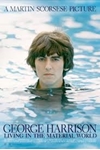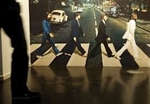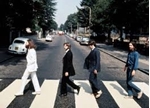- Register
- Log in to Tune-In
- Wishlist (0)
-
Shopping cart
(0)
You have no items in your shopping cart.
Beatles News

The Beatles album Abbey Road has reached the top of the UK album charts for the second time – 49 years and 252 days after it was first at No 1.
A deluxe reissue of the album was released to mark its 50th anniversary, though it may struggle to match the 17-week run the original release had at No 1.
Paul McCartney hailed the news. “It’s hard to believe that Abbey Road still holds up after all these years,” he said. “But then again, it’s a bloody cool album.”
The artist knocked off top spot by the Beatles is one the band have heavily influenced: Liam Gallagher, with his second solo album Why Me? Why Not. Back up four places to No 3 is Lewis Capaldi, whose debut album Divinely Uninspired to a Hellish Extent was named this week as the year’s biggest-selling so far at 423,000 copies. At No 4 is the south London rap group D-Block Europe, scoring their highest chart placing yet with their 28-track mixtape PTSD.
Source: Ben Beaumont-Thomas/theguardian.com
details
The Beatles weren’t virtuoso musicians, and they were usually the first to admit it. When John Lennon spoke to Playboy’s David Sheff in 1980, he put it this way: “Not technically great. None of us were technical musicians. None of us could read music.”
In 1977, George Harrison spoke about how his guitar technique slipped in the late ’60s. It was pretty simple: He stopped playing guitar for three years to focus on the sitar. When he picked up his guitar again, he focused on slide because he felt “so far behind in playing hot licks.”
As for Paul McCartney, the best all-around musician in the band, he spoke of how difficult it was for him to play the piano riff on “Martha My Dear.” That leaves Ringo, a drummer who refused to take a solo until the last track of the band’s last studio album.
Source: cheatsheet.com
details
Paul McCartney has paid tribute to his childhood friend and the broadcast journalist Peter Sissons.
Earlier on Wednesday, a spokesperson revealed that the much-loved BBC and ITV newsreader had died at the age of 77 in hospital.
Before finding fame in their respective careers, Sissons and McCartney had been schoolmates and both attended the Liverpool Institute together in their youth.
Speaking out on Tuesday, the Beatles singer shared an open letter to his friend on his official blog.
Paul wrote: "Dear Peter, my old school mate from the Liverpool Institute (now LIPA) has passed away. It’s so sad to hear the news. We were in the same year and stayed in touch as time went by and we both followed our separate careers.
Source: Lucy Needham/mirror.co.uk
details
The Emmy-award-winning Martin Scorsese documentary George Harrison: Living in the Material World presents previously unseen footage to tell the story of Harrison’s life, music and spirituality.
The 2011 documentary film discusses Harrison’s growing up in Liverpool, his role in the Beatles and his travels in India. New interviews, unseen footage and a fantastic soundtrack are all used to tell the musician’s story.
The documentary is available on Amazon Prime and is purchasable on DVD.The documentary is based on the life and music of George Harrison. It covers his childhood, his time in The Beetles and his solo career.
Source: George Storr/radiotimes.com
details
Perhaps one of the weirdest moments on the latest Beatles remix-and-outtakes collection is a bit where the boys have just crapped out on a take of “Maxwell's Silver Hammer,” and, as Paul McCartney requests another attempt at the song, George Harrison references — of all bands — the MC5. “'Kick Out the Jams,' take eight,” Harrison jokes. Ringo Starr then screams “Brothers and sisters!” like Wayne Kramer and starts wailing on the snare drum.
A couple things. One, that The Beatles were aware of the MC5 seems strange, even though it's evident from this tape that they were. It's funny somehow to picture Starr and Harrison getting into the radical left-wing proto-punk MC5 around the same time they were making “Abbey Road,” but there it is. Another thing is, you get the distinct sense that they'd rather be making gritty rock than subjecting themselves to another grueling session where McCartney made them play another of his fluffy tunes 50 times.
Source: duluthnewstribune.com

When you think of George Harrison’s time in The Beatles, it’s easy to focus on Abbey Road, the Fab Four’s final studio album. After all, two of George’s most celebrated songs — “Something” and “Here Comes the Sun” — landed on that record.
However, George didn’t see his work on Abbey Road (1969) as any sudden flowering of his songwriting abilities. He thought his four songs on The White Album (1968) — and those that didn’t make it on the record — stood up to that pair of tracks. (Think: “While My Guitar Gently Weeps.”)
Considering George had three songs on Revolver (1966) and just one on Sgt. Pepper’s (1967), it’s probably best to think of him having several peaks with The Beatles. And when George looked back at his favorite work with the Fab Four, he thought of the band’s second 1965 album as the highlight.
Source: cheatsheet.com
details
With its cheery singles, theatrical medley and iconic cover, The Beatles’ 11th studio album, “Abbey Road,” holds a special place in the hearts of the band’s fans.
But as the album celebrates its 50th anniversary, few may realize just how groundbreaking its tracks were for the band.
In my forthcoming book, “Recording Analysis: How the Record Shapes the Song,” I show how the recording process can enhance the artistry of songs, and “Abbey Road” is one of the albums I highlight.
Beginning with 1965’s “Rubber Soul,” The Beatles started exploring new sounds. This quest continued in “Abbey Road,” where the band was able to deftly incorporate emerging recording technology in a way that set the album apart from everything they had previously done.
Source: snopes.com
details
The album cover for The Beatles’ “Abbey Road” is one of the most iconic in music history. The 1969 cover art features the four members of the band crossing the London street, and while Ringo Starr, John Lennon and George Harrison are all wearing shoes, Paul McCartney is barefoot. Over the years, some whacky conspiracy theories have been posited to explain why the musician did not wear shoes in the shot.
Falling in line with another rumor that was gaining traction at the time — that McCartney had died some years earlier and had been replaced by a lookalike imposter — some believed that his lack of shoes in the photo symbolized a funeral procession. Lennon represented a clergyman in white, while Starr’s black clothes were that of a mourner. Harrison’s denim outfit made him the gravedigger.
Source: Kate Streit/simplemost.com
details
Fifty years ago this month, The Beatles came out with Abbey Road — the last album they ever recorded as a group, and, alongside Let It Be, the closing cap on their decade-long tenure as the biggest popular phenomenon in musical history.
Abbey Road has a singular feel compared to the rest of their albums: at once cohesively recognizable as its own project and easily traceable to their other work. It received mixed reviews upon its release, but its critical and public reputations have only grown in the 50 years since, thanks partly to expanding perspectives and partly to the increasing and almost mythical feeling of finality surrounding it. The Beatles quit while they were ahead about as surely as a band can, and they never attempted any comeback albums or tours or performances that might have diluted their closing curtain or tacked something else onto it — meaning, Abbey Road is it.
Source: Laura Dzubay/consequenceofsound.net
details
While John Lennon ended up feeling trapped by The Beatles, he probably looked back fondly at most of the band’s recording sessions. After all, he had bandmates who understood him unlike any other musicians and a producer (George Martin) who put out good records without fail.
When Lennon went solo, he teamed up with legendary producer Phil Spector. Their early collaborations, including Plastic Ono Band and Imagine, were major successes. However, if you watch the Imagine film, you can tell things weren’t always going smoothly. (Lennon berating Spector is one clue.)
By late 1973, the relationship hit an even rougher patch during the sessions for Lennon’s Rock ‘n’ Roll in Los Angeles. These dates fell during the period his estrangement from Yoko Ono and extended booze-and-drug fest known as John’s “lost weekend.”
Source: cheatsheet.com
details
While The Beatles released Let It Be in 1970, most of the recordings for that record were already finished by early 1969. So Abbey Road turned out to be the last record they made as a band. Fittingly, the last bona fide track on the record is “The End.”
Looking back, you could make the case that the end was in sight by the close of that summer (’69). After all, every Beatle had voiced his discontentment or walked out on a recording session by then. And John Lennon, who’d founded the group in the ’50s, had become bored with the program.
However, John hadn’t fully given up on the band when they finished with the Abbey Road sessions late in August. In a tape recently unveiled by Beatles scholar Mark Lewisohn, you can hear John planning for a future album while talking with his bandmates in the second week of September.
While John would announce he was quitting two weeks later, the recorded meeting with Paul McCartney and George Harrison reveals he had not yet crossed that final line.
Source: cheatsheet.com

When The Beatles issued Abbey Road on Sept. 26, 1969, the hi-fi revolution had yet to take hold. Most people would have heard it on cheap portable record players with plastic tonearms or through hulking console stereos that masqueraded as furniture.
This meant that even though the album was recorded using the very best technology of the day — it’s the first Beatles album to use both eight-track multi-track recorders and a solid-state mixing console — George Martin and his crew had to be very respectful of the limitations of the playback equipment of the day. No one wanted the needles jumping out of the groove during passages of deep bass, nor was there any point worrying about capturing all the high frequencies.
Abbey Road has been reissued numerous times since then (most notably with 40th-anniversary remaster in 2009), each utilizing the latest tech to enhance and clean up what was committed to tape between February and August 1969.For the album’s 50th-anniversary, Giles Martin, son of George, was entrusted with giving Abbey Road a top-to-bottom inside-out refurbishment using the original source materials. This newest version — surely the clearest, best-sounding version ever — w
details

Giles Martin, music director of the Elton John biopic Rocketman, has revealed the movie’s strong association with Abbey Road Studios in London.
Martin’s father, George, helped secure the complex’s part in history as he produced Beatles albums there in the ‘60s. Giles has taken over the mantle, having been involved in the band’s reissue series in recent years.
But he also explained that Abbey Road played a major part in the creation of John’s movie, which ended its theater run earlier this month.
“Our first session we did for Rocketman, our first training with [star] Taron [Egerton] learning to be Elton, was done in this room, actually,” Martin said in a studio video. “It was an 18-month process from start to finish, Rocketman. It was a great project; it’s been really well-received. … Rocketman is quite fantastical and weird. You’re never quite sure if you’ll be laughed out of the building or not, and you just try and do what you think is right. It was a really fun project.”
Source: ultimateclassicrock.com

The Beatles icon Paul McCartney had Aston Martin years ago, and actor Patrick Stewart revealed he was poorly driving the car when he was a 24-year-old with Paul in the passenger’s seat, and he feared he was going to kill him with his reckless driving. Paul McCartney ripped some of his ‘stupid’ releases earlier this week.
“We drove from Bristol to Bath and back. And all the way Paul kept saying, ‘Come on put your foot down, overtake, overtake.’ And all I could think was, ‘If I killed Paul McCartney …'”
He also said via Evening Standard, “I saw Paul and Ringo about six weeks ago, just by accident, by chance in a restaurant. And it is always whenever I meet Paul as though no time has passed at all. He has an immediacy of behavior, a spontaneous way of behaving which is remarkable.”
Source: Brett Buchanan/alternativenation.net
details
If you want to know who wrote a particular Beatles song, a big clue is the lead singer. When you hear John Lennon on the vocal of an original track (e.g., “Strawberry Fields Forever” or “Come Together”) it’s a safe bet he was the composer.
The same goes for songs featuring Paul McCartney (“Martha My Dear“) or George Harrison (“Savoy Truffle“) on lead vocals. But there were exceptions during the Beatles’ epic run. Early on, John passed “Do You Want to Know a Secret” to George for him to sing. (He thought it suited George’s range.)
Later, for Sgt. Pepper’s, John and Paul collaborated on “With a Little Help From My Friends” with the understanding Ringo would sing it. John’s “Good Night” (also for Ringo) on The White Album falls into this category as well.
However, you weren’t going to see John writing a song for Paul to sing (or vice versa). They just didn’t work like that. Looking back, John pointed to one Abbey Road song he thought he could have taken off Paul’s hands — and done a better job on vocals, too.
Source: cheatsheet.com
